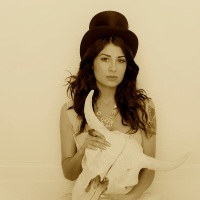The Feral Life #1: The Feral Dream
A woman, dressed in rags and furs, carelessly filthy, black stringy and presumably lousy hair, teeth unsubjected to any dentistry and poisonous as a hyena’s, her face cocked like a gun preparing to explode, enters the lair of a wolf. The animal growls. The human brute growls back even more ferociously. The camera does not show us but we hear the beating and the tearing of those human teeth. In a moment we see her running, perhaps it is a dream. But in this story the woman who runs with the wolves is no sub-Jungian New Age empowerment fantasy. This is a fearful thing.
The film is The Woman. It was released in 2011 and more recently for home digestion. Directed by Lucky McKee, who also directed the brilliant watch-at-your-own-risk May back in 2002, The Woman has been vilified as misogynist, far too gory and just plain nerve-wracking and simultaneously praised for it’s feminist undertones and unique character portrayal by Pollyanna McIntosh. It is indeed quite hard to believe that Pollyanna (Has anyone ever been more paradoxically named?) is actually a statuesque Scottish beauty. But all of this contradiction delineates clearly the manner of beast we have here.
And as I watched this grisly work of art I was struck by many details that resonated far beyond the confines of this inexpensive little indie film. The screenwriter, novelist Jack Ketchum, had continued his novel, The Offspring, with special emphasis on the Woman at the suggestion of producer Andrew van den Houten, who had directed a version of the earlier book. The film of The Offspring also starred Pollyanna McIntosh as the Woman, leader of a tribe of feral humans in the American Northeast. And it is in fact this notion of feral humanity that really jumped out at me with such force in both films.
Feral is a curious word. (By the bye it can be pronounced in two ways. One, the more standard, makes it sound like fair-al. The other less common pronunciation is more like fear-al.) It suggest not merely wild, or wildness, but of the domesticated thing returning to the wild. For instance if you showed up on the Kerguelen Islands in the Southern Indian Ocean you would find a healthy population of feral cats that had been left behind by sailors from centuries back to eradicate the rat infestation accidentally bestowed upon the islands. I am claimed by a feral cat myself here in Alaska. They can go in and out a feral state. And that is very different from the human race. This could have something to do with the fact that domestication depends entirely on an animal’s relationship to mankind. We are not tamed by our pets or cattle. Now before I tread too far into some politically incorrect screed let’s return to ferality.
So to be feral is to revert to a wild state. Now at this point we bump into a raft of cultural issues that have their primary origins back in the writings of Jean-Jacques Rousseau who theorized most famously that ‘L’homme est né libre, et partout il est dans les fers.‘, which translated says that, ‘Man is born free; and everywhere he is in chains.‘ It was clear from his writings that Rousseau lamented the state of society that had enslaved us. All those compromises! All that book learning! All of that conformity! The individual must be free as an individual! Vive la Revolution!
Another related idea is that of the ‘noble savage’. Rousseau did not invent the concept nor was he as primitivist as it sometimes claimed. Yet the somehow a reduction of his idea comes down to us like this; that the most free folks on earth are those most free from civilization, those closest to nature and the earth. Rousseau praised children for their purity, primitive tribes when they had achieved the stage of the savage. Regardless of the subtleties of Rousseau’s very influential works, the concepts of the ‘noble savage’ eventually merged with the art movements of 19th Century French Bohemia.
French Post-Impressionist Paul Gauguin followed a quest for this kind of wild life when he left behind everything and followed his muse to Tahiti. There was vision at the time that the Tahitians and many other tribes were more liberated than the stale old bourgeois European world that he had left behind, along with his failed marriage and children and the sense of depression that led him to attempt suicide. He wanted to find something in Tahiti. Something he was missing. Yet it could not be found. When he did eventually paint his masterpiece, D’où Venons Nous? Que Sommes Nous? Où Allons Nous? (trans. Where Do We Come From? What Are We? Where Are We Going?), this was not the work of a man who had found his boho dreams come true. Death and futility are writ large. Paradise, not a paradisaical as the dream. A great painting had been made but the Tahitians were pretty much stuck on the same earth as everyone else.
Nevertheless more and more souls began to empty themselves out into various jungles of the mind in search of the perfect primitive conditions of liberation. Expressionist movements like Les Fauves, the very word meaning wild beasts, followed Gauguin into the primitivist wilds. In fact so much of modern art can be seen as a various forms of rejection of the things that make up the a dull conformist society: a return to nature, a rejection of nature, the artist as prophet, the artist as shaman, the artist as outlaw, the artist as madman, the artist as barbarian, the artist as explorer at the edges and the artist as denizen of the dregs. And all the while the dream of a feral sort of existence haunts the proceedings.

The Surrealist Unconsciousness – Un Chien Andalou (The Andalusian Dog) 1929 Luis Bunuel & Salvador Dali
The Surrealists perfected perhaps the most intellectual version of this dream… which is of course an oxymoron. Yet one has to hand it to the Surrealists, whom I have a great deal of respect for. Following Symbolist dream theory and folding into it a strong dose of early 20th Century Sigmund Freud’s reduction of human psychology to the libido, the Surrealists sought among the detritus of tainted experience in childhood, the metal institution and other outsiders for a way to connect, beyond reason, to the meaning of Art and Life. Later artists would discover Carl Jung.
But finally a movement would come along that would bubble up higher than the demimonde of the arts. The Beat Generation were by the late 1940’s pickled in Rousseau’s individualistic liberation dream. All that matters is to be true to yourself. That is the final statement. (With the proviso ‘as long as you don’t hurt anybody’ whatever that means. Actually that is the nail in the noble savage’s coffin.) But the Beats had a few nice twists in the lime of Rousseau’s gin and tonic. One, sex, and lots more of it. Two, drugs, and lot’s more of them. And finally music, or should I say Jazz, with Charlie Parker, (Oops! Sorry! Dead from primitive aid number two!) or Miles Davis in the role of the prophetic noble savage. We’ll overlook the hidden racism in considering black jazz players as noble savages with a pipeline to the primitive urges and demiurges. Did anyone ever at the time notice that being black did not equate to being more in touch with the mysteries of the savage universe? Great musicians? Yes. Fresh from the jungle? Um? Not quite. Pretty damned intellectual actually. So let’s change that addition from Jazz, just cross that out, to let’s look around a little… Oh! Wait! What’s this wild primitive stuff over here? Oh yeah! Rock ‘n’ Roll! And voila sex, drugs and rock ‘n’ roll (!) equals another variation on the noble savagery theme.
Okay. I’m well aware that white American asses in the 1950’s had gotten damned tight and needed some musical loosening. But in plain fact, find one 1950’s rock ‘n’ roller that was truly in Rousseau’s camp. This was a case of the noble savage interpretation of what was actually fairly standard electric folk music in the traditional American vein. Had Postwar America not been quite so somnambulistically square it would not have been seen as such a radical departure from Jazz or the Blues. Nevertheless by the late 1960’s this Rousseau interpretation of Rock music was standard. (See the burgeoning field of Rock criticism.) Rock had indeed become a revolt against civilization. LSD was the psychosomatic magic which would effect the liberation of desire. Down with Christian prudery! Down with humanistic rationalism! Hey, hey, ho, ho, Western Civ has got to go! Vive la Revolution!
And now the feral dream was out of the intellectual closet.
(Next time we continue our little survey of the wilderness from Woodstock to the Texas Chainsaw Massacre to the Virgin Prunes)
Byrne Power
Haines, Alaska
5/17/2012
Also here’s another Anadromous essay on a similar theme…














Escape. Neo-primitivism is another attempt at this. Who wouldn’t want to escape modern detachment? There is little to grab onto in this age apart from consumer goods and each other. Freedom represented as wild is a sweet beconing siren to those of us weighted down by technological life. The impartial way in which we meet our end in the wild is much more welcoming to me that the plastic and electronic simulation of life found in a hospital, or god forbid, a “retirement home.” We have been too socialized to fear total feral degredation, haven’t we? Unless born into the wild by perhaps a sick experiment, like in “The Woman” we are still subject to our heavily indoctrinated norms. Isolation can drive a person mad, yet this can happen just as intensely in the lonely crowd. Going forward in the current direction signals doom, going back, at least all the way back, seems impossible. Where do we go from here? Perhaps we should concentrate on just having fun…
May 29, 2012 at 9:11 AM
Yeah AK I guess there are traps on both sides of any issue. Our imitation wildlife is the flip side of our containment. You are reminding me that maybe I should concentrate on ‘fun’ in the future.
May 29, 2012 at 2:58 PM